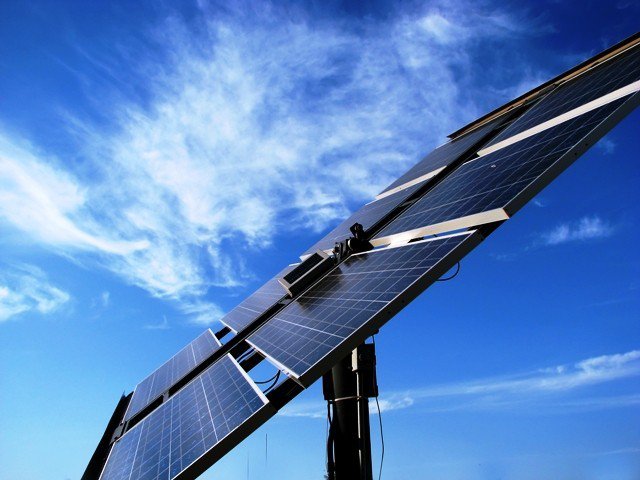
These factors are now linked to the economic development of nations through energy economics. However, global energy scaling is hindered by international climate control treaties such as the Kyoto Protocol (Japan, 1997) and numerous United Nations Climate Change Conferences over the years (COP21, France, 2015; COP22, Morocco, 2016; COP23, Germany, 2017 and COP24, Poland, 2018).
Member states from around the world are allotted year-on-year Green House Gas (GHG) emission mitigation targets for curbing the impact of global warming. These communal gatherings for emission consensus are a result of 0.2-degree Celsius projected rise in temperature per decade globally due to emissions in the next two decades.
US company to invest in Pakistan’s solar energy sector
Even so, if the concentrations of GHGs were not to change, rise in sea level and anthropogenic warming would occur for centuries.
Pakistan’s current energy mix includes fossil fuels (furnace oil, natural gas and coal) and renewables (hydroelectric power, wind and solar) across its geographical vertices. The country stands at 169th place in the Environmental Performance Index (EPI) out of the 180 countries included in the study.
Although past and present governments consistently claim supply-demand parity, what still remains unanswered is the lack of rural electrification due to a low transmission/distribution network spread or grid proximity (70% of Pakistan is rural and overall grid connectivity stands at 42% to date), high cost of well-to-consumer for a multitude of reasons (dilapidated development infrastructure, shortage of investment, lack of intrinsic resources, security, etc), rising fuel import bill, under-utilisation of existing power plant capacities, shortage of fuel transport civil linkages, to name a few. All of these sources of energy generation are dirty, especially coal, and except solar.
Solar is one such clean energy resource that has made strong headway in recent years. It is by far the most popular renewable energy resource relative to its peers due to its low operational/maintenance cost, ease of installation/use and zero GHG emissions. For a country like Pakistan, solar energy is particularly suitable due to its optimal geographical location. In comparison with many European countries, most cities in Pakistan receive about 1,500-2,500 hours of sun annually, which is twice more than that of Europe.
Balochistan is particularly rich in solar energy with annual mean sunshine duration of 8-8.5 hours per day and these values are one of the highest in the world.
Unfortunately, with the technology being clean, cheap and abundant and climate platform ideal, it is a surprise that solar adoption to this day remains low in Pakistan. With several policies being passed, frameworks introduced and consultancies being sought over the last 10+ years, we as a nation have not been able to fully maximise this energy source as a value addition to the national grid.
One of the main challenges comes not from government regulations, theft or mismanagement, but from the technology itself. Solar has the good fortune and a bad omen of being relatively easy to set up, compared to other renewables (such as biogas, hydro, wind, etc).
It is often commonly misconstrued as a do-it-yourself (DIY) exercise in Pakistan. Therefore, the price variation through over-customisation of solutions has rendered not only the end-user confused but also misinformed.
From street vendors in Rawalpindi to SMEs all are equally to blame for the muddle in the solar energy price control, incomplete installations, workforce misuse, misappropriation of public wealth, indecisive policymaking and unaccountable billing.The Quaid-e-Azam Solar Park is one prime example of such public-private partnership conundrum, which was hailed as a symbolic beacon of clean energy in the country.
Recommendations
From a policy standpoint, the government entities must adhere to the following recommendations for a successful renewable energy transition from the current energy climate of the country:
- GHG policies and regulation: Government should promote and implement green energy policies for resource portfolio diversification, resource availability and accessibility, infrastructure development planning, socio-economic prosperity and social welfare, geopolitical affluence and long-term sustainability of the country.
- Technology: This comes in two parts:
- Incentivise solar manufacturers by providing a conducive investment climate for product launch, marketing and awareness, logistical, operational, contractual, managerial and financial assistance in either a joint-venture partnership with local government/private entities or by allocating sole trader rights with long-term contracts.
- Incentivise consumers with green tax rebates and bonuses with net metering via upfront tariff by governmental regulatory procedures.
- Infrastructure requirements: Facilitate installation of solar technologies by creating service, operation and after-sale maintenance procedures and protocols, in a transfer-of-technology strategy collaborated with international solar companies.
- Target market segment: The network should target households rather than IPPs as is the failed approach to date. The segment of interest should be rural geographical settlements conducive to solar, as these would not only act as self-sustaining energy consumers but also energy sources forming point-size energy generators in the overall schematic of a micro-grid. These micro-grids would eventually connect to the main national energy grid and act as actual contributors of electricity.
- Market regulators: The responsibilities of regulating bodies are restricted to electricity generation licensing, establishing standards and control for electricity generation and cooperating with regional/international consortiums for efficient supply of solar energy and upfront tariff pricing.
- Assets & communication: Ownership, responsibilities, operations and maintenance responsibilities have to be dedicated and streamlined within a framework including solar manufacturers, green government entities, management, infrastructure upkeep, power sector and transport authorities, consumer welfare departments and customer care. All communication channels should be established for efficient running of the system where all participants are monitored for a successful delivery of service.
10,800 schools to convert to solar power
Pakistan can make use of this freely available and widely distributed solar energy for improving socio-economic conditions of the people living in remote areas and for reducing the poverty level. Harnessing the sun’s power is considered an attractive alternative because it is a renewable resource, causing zero pollution.
In contrast to conventional fuels, its use eliminates the need for refining, transporting and conveying fuels and power over long distances. If this potential is left untapped, we might never limit our emissions and remain fuel importers for decades to come.
The writer is a PhD in Engineering from the University of Cambridge, United Kingdom and is an expert in emerging technologies
Published in The Express Tribune, July 08th, 2019.
Like Business on Facebook, follow @TribuneBiz on Twitter to stay informed and join in the conversation.










































COMMENTS
Comments are moderated and generally will be posted if they are on-topic and not abusive.
For more information, please see our Comments FAQ